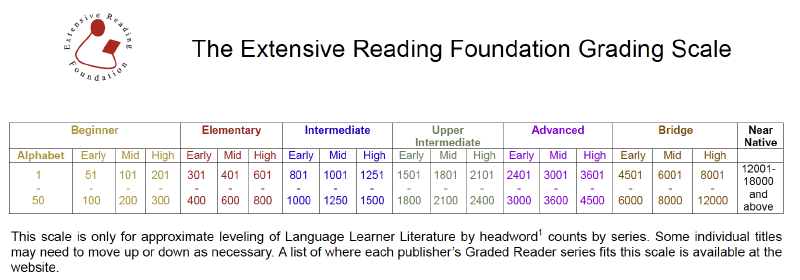Purpose
The Extensive Reading Foundation (ERF) has made this scale to:
- allow teachers to categorize their library of graded readers along an easy to understand Scale
- match this Scale with the levels the ERF uses for the Language Learner Literature Awards
- have a uniform Scale so that different series from different publishers can be compared in terms of difficulty and placed together
- provide a sense of uniformity between institutions. Students moving between institution will remain aware of their level
- provide a framework for publishers to consider what levels they may wish to publish at.
The levels
The levels were determined through extensive analysis of hundreds of graded readers on the market. The main features are that the Scale:
- goes from the Alphabet level (50 headwords) to Near Native (18,000 headwords) and thus includes materials other than graded readers (e.g. the new mid-frequency readers which go up to 8,000 headwords).
- is divided into 5 readily-recognizable levels each with three sub-levels for finer classifications.
- is based on headword counts only
Note that this scale is NOT based on wordlists. It is based on the reported headword count for each level of a publisher’s series. So for example, if Cengage’s Foundations Reading Library Level 3 is said to be 200 headwords, then it will be rated Beginner Mid (101-200). No wordlists are available from the ERF. If you wish to know a publisher’s wordlists by level, please contact the publisher.
Click on the image to download a version suitable for distribution
How to use the Scale
Teachers should find the headword count of the books they wish to categorize (say 300 headwords) and see where it fits the Scale. The books can then be labeled at that level for easy selection by students. For example, an Oxford Bookworms book, Level 1 is a 400 headword book and should be labeled Early Elementary. A Cengage Foundations Reading Library Level 3 book (150 headwords) should be labeled Mid-beginner. Teachers may wish to use shortened forms, for example M-Int and E-Adv might refer to Mid-Intermediate and Early Advanced. The books can further be color coded by level (or put in leveled boxes) so students can easily find them and put them away after use.
The ERF does not recommend teachers categorize books by the advertised proficiency level on graded readers. An Intermediate book in one series may be Elementary in another and Advanced in yet another. The ERF believes there is too much variability in these labels and we recommend teachers use headword counts which tend to be accurately determine levels.
A full table of where each publisher’s series fits the ERF Graded Reader Scale can be found here. If a series does not have headword counts, then the ‘comparison table’ at the above link may help you to categorize the books into appropriate levels.
This does not mean your institution has to abandon its present rating system. However, the ERF is aiming at uniformity in all ER programs worldwide so students moving from one school to the next are familiar with one system so we recommend you use the ERF system as well your institution’s own system.
Telling the Students
Make sure you have a copy of the Scale printed for the students to see as they select books and ensure that the books in your library match the Scale. Show them how your books are coded and ensure they know which the upper and lower levels are.
How can students know their fluent reading level?
Ask them to pick up books at various difficulty levels (once they know what the levels are) and read a little of each book for a few minutes. As they read, they should ask themselves these questions.
- Can I read it without a dictionary?
- Am I reading it quickly?
- Do I understand almost everything?
If the answer is yes to each of these questions, then that book is their level or they could try a higher level. If the answer is no to even one of the questions, then they should go down levels until they have 3 yes answers.
Notes
1. A headword is similar to a dictionary entry where a group of words share the same basic meaning. E.g. helps, helping, helpful, helpless.
2. The Scale is not supposed to be used literally. It is a rough guide to categorizing books by difficulty. As not all books at a given level by a publisher are equally difficult, some individual titles may need to go up or down as necessary and these books will need relabeling.
3. Grammatical difficulty was not used in informing the levels for several reasons
- publishers do not use the same grammatical syllabuses.
- headwords are easy to understand.
- even though not all publishers use the same words at the same headword count, the natural frequency in English tends to ensure that the words used at the same level by different publishers will be roughly equal.
The amount of reading your students should do is shown here in the Reading amount calculator.
